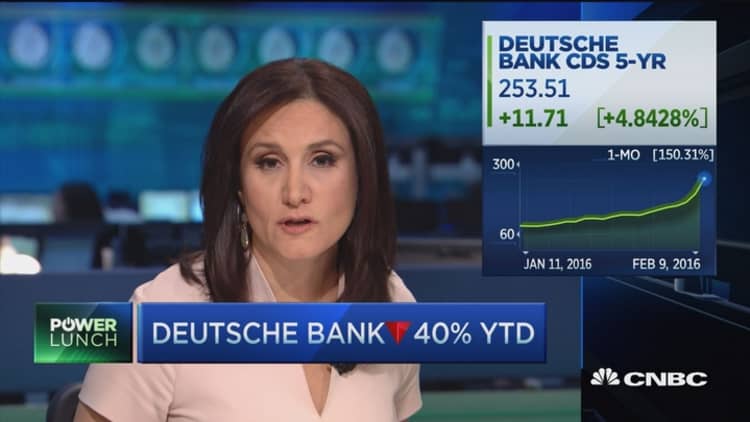European banks appear to face greater long-term exposure to problems in the energy sector compared to U.S. banks, many of which have already shored up capital reserves for half of their energy debt portfolio.
Numerous European banks have not yet seen their borrowers draw down much of the credit that has been allotted for them, or, even more perplexing to analysts and investors, aren't saying what their exposure to commodity-sensitive credit is, or what has already been committed.
At the Credit Suisse Financial Services Conference this week in Florida, several bank executives highlighted the total exposure of their balance sheets to energy debt, but also explained what percentage of that exposure is made up of outstanding paper.
Wells Fargo CFO John Shrewsberry highlighted the bank's $42 billion in total oil and gas credit in his presentation at the conference; 41 percent ($17.4 billion) is already outstanding. The lender already has prepared for losses in outstanding paper by setting aside $1.2 billion to offset credit losses.
The difference between Wells' energy exposure and many of its competitors is that much of the California-based bank's paper is non-investment grade. But the finance chief doesn't sound like he's sweating it.
"This is not new for Wells Fargo," Shrewsberry said at the event, and he noted "most of these loans are senior secured credit facilities."

However, European banks may have an even greater need to shore up capital. Many have billions in energy credit still waiting to be drawn down, which in turn could impact how much reserves must be set aside to bolster against defaults.
Credit Suisse CEO Tidjane Thiam spoke at the conference run by his bank Wednesday, and explained that while the company's total energy exposure represents $9.1 billion, only $2.4 billion (about a quarter) of that had been drawn down by borrowers.
In a JPMorgan report, analysts highlighted energy exposure for banks including Barclays, Standard Chartered, Royal Bank of Scotland and BNP Paribas. All told, the banks' commodity exposure represented nearly $150 billion, much of which is yet to be drawn down, according to the report.
Deutsche Bank didn't quantify what its full energy exposure is in its fourth-quarter results, although, according to S&P Global Market Intelligence analyst Julien Jarmoszko, the lender has a lower exposure than its bigger competitors.
Read MoreFalling odds of Fed hike hurts banks
In its fourth-quarter earnings report, BNP Paribas highlighted $38.27 billion in total commodity exposure, and noted that 75 percent of that is investment grade. Standard Chartered reports results later this month; Barclays earnings are scheduled for March 1.

Other U.S. banks quantified total energy credit exposure in their fourth-quarter earnings, and compared them to existing commitments. Citigroup's total exposure is $58 billion, of which $20.5 billion has already been funded. Bank of America's total energy credit exposure amounts to $43.8 billion, but more than $21 billion of that has already been funded.
Further, banks' investment-grade paper varies on a company-by-company basis. Whereas Bank of America's $43.8 in total exposure is 80 percent investment grade, according to a recent Goldman Sachs analyst report, Wells Fargo's energy loans are "mostly" non-investment grade.
U.S. banks' commitment to debt varies; the companies with the greatest exposure have already issued a third to as much as half of companies' debt. JPMorgan's exposure represents about $42 billion; according to the Goldman Sachs report, $13.8 billion (roughly 33 percent) of that has been assumed. And Morgan Stanley has thus far funded about 30 percent of its $16 billion exposure to energy credit, its CFO Jon Pruzan said on the company's fourth-quarter earnings call, of which 60 percent is investment-grade rated.
Analysts have criticized many European banks in 2016 for shortcomings, relative to that of their U.S. counterparts, in raising capital buffers in the wake of the global financial crisis. How banks report (or obfuscate) their exposure to energy and current level of commitments may serve to crystallize both regulators' and shareholders' view of managers.
Read MoreEuropean banks face major cash crunch
In his question-and-answer session before the conference's conclusion, Thiam offered a tepid prediction.
"I am more optimistic than I used to be," said Thiam, who joined Credit Suisse less than a year ago. "I may regret saying that."






